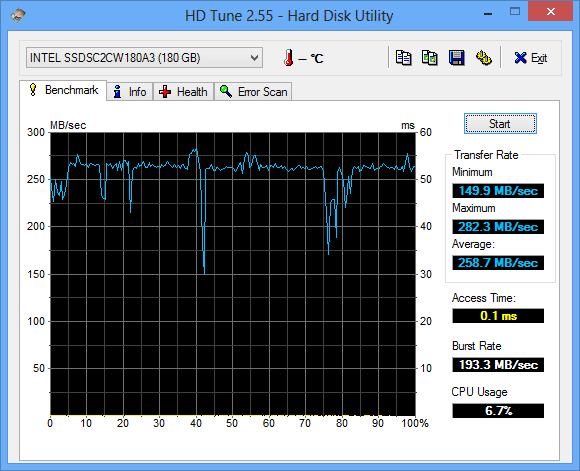

AnandTech Storage Bench - Heavy - IO Breakdown The total number of IOs is less than 10% of The Destroyer's IOs, so the Heavy trace is much easier for the drive and doesn't even overwrite the drive once. A part of that is explained by the lack of virtualization because operating systems tend to be read-intensive, be that a local or virtual system. The Heavy trace is actually more write-centric than The Destroyer is. The Heavy trace drops virtualization from the equation and goes a bit lighter on photo editing and gaming, making it more relevant to the majority of end-users.
#Intel 750 ssd benchmark windows
AnandTech Storage Bench - Heavyīrowse the web, manage local email, document creation, application install, virus/malware scanĬhrome, IE10, Outlook, Windows 8, AxCrypt, uTorrent, AdAware By writing less to the drive, the Heavy trace doesn't drive the SSD into steady-state and thus the trace gives us a good idea of peak performance combined with some basic garbage collection routines. However, everyone else will be better served by the £430 Samsung EVO 850 PRO, which costs significantly less and is still one of the fastest SATA SSDs around.While The Destroyer focuses on sustained and worst-case performance by hammering the drive with nearly 1TB worth of writes, the Heavy trace provides a more typical enthusiast and power user workload.
#Intel 750 ssd benchmark Pc
If you have a compatible motherboard, demand the absolute best from your PC and don’t mind spending close to £1,000 on storage, the Intel 750 Series is nigh-on unbeatable. The 750 Series might be twice the price of the fastest consumer-grade 1TB SSDs, but it’s also twice as fast. Small file read speeds were a stunning 184MB/s, the fastest we’ve seen and more than twice the speed of a traditional SATA SSD. Our small files test has always been tough, but write speeds of 116MB/s were still around 30MB/s faster than the best SATA SSDs. This is more than twice as fast as anything we’ve seen previously, and a sign of things to come for SSDs now that the SATA interface is no longer the limiting factor in transfer speeds. Our previous fastest SSDs topped out at around 600MB/s, but the 750 Series managed an incredible 1,386MB/s write and 1,452MB/s read. The SSD puts all that power to good use, however, producing without a doubt the fastest speeds we’ve ever seen in our storage benchmark tests. Thankfully the PCI Express interface can deliver this much power without needing to be plugged into an additional power supply cable, which should help keep your system neat.
#Intel 750 ssd benchmark full
The 750 Series SSD uses an 18-channel flash controller of Intel’s own design, which runs at 400MHz and can draw up to 25W when in full write mode – hence the reason Intel has fitted a sizable heatsink that covers the SSD’s entire circuit board. The SSD did slow down slightly compared to running the same test without stressing the graphics card, but only by as much as 9% – not enough to notice, and not a situation you’re likely to encounter in everyday use.

In our testing, we didn’t see any frame rate decreases in Metro: Last Light Redux, running on an Nvidia GeForce GTX 980 at a resolution of 3,840×2,160 while running the CrystalDiskMark storage benchmark in the background. Officially, only Intel’s own Z97 and X99 chipsets are supported, and because Z97 motherboards only have 16 PCI Express lanes you will have to share bandwidth between the SSD and a dedicated graphics card. Unfortunately not all motherboards will be able to supply enough bandwidth to achieve such incredible speeds. The 750 Series uses four PCI-Express lanes at PCI Express 3.0 speeds, and to accesses data in parallel, rather than sequentially, which Intel claims will provide read and write speeds of 2,400MB/s and 1,200MB/s. Whereas SATA has a maximum usable bandwidth of 550MB/s, NVMe is almost six times faster at 3,200MB/s.

The SSD is based on the Non-Volatile Memory Express (NVMe’) specification – a standard designed specifically for SSDs, unlike the traditional SATA interface which was originally built for much slower mechanical hard disks. Intel’s latest SSDs are based on hardware that was originally designed for enterprise-grade workstations and servers, but there has been enough consumer demand for the company to rebadge its hardware as the 750 Series – a PCI Express slot SSD that’s undoubtedly the fastest storage device we’ve ever tested.


 0 kommentar(er)
0 kommentar(er)
